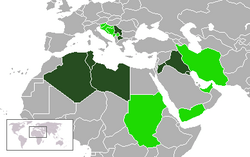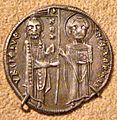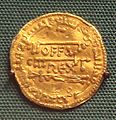Dinar facts for kids
The Dinar is the name of the official currency in several countries. The word dinar (Arabic: دينار, Serbian: динар / dinar, Macedonian: денар) is derived from denarius, a Roman currency.
Contents
Legal tender
Countries currently using the dinar
| Countries | Currency | ISO 4217 code |
|---|---|---|
| Algerian dinar | DZD | |
| Bahraini dinar | BHD | |
| Jordanian dinar | JOD | |
| Kuwaiti dinar | KWD | |
| Iraqi dinar | IQD | |
| Macedonian denar | MKD | |
| Libyan dinar | LYD | |
| Serbian dinar | RSD | |
| Tunisian dinar | TND |
Countries which have previously used the dinar
- Abu Dhabi: the Abu Dhabi dinar or Bahraini dinar which have been used from 1966 to 1973
- Bosnia and Herzegovina: the Bosnia and Herzegovina dinar
- Croatia: the Croatian dinar
- Iran: the Iranian rial was divided into 100 dinars
- Republic of Serbian Krajina: the Krajina dinar
- Republika Srpska: the Republika Srpska dinar
- South Yemen: the South Yemeni dinar
- Sudan: the Sudanese dinar
- Yugoslavia: the Yugoslav dinar
Images for kids
-
Silver dinar from the reign of Serbian king Stefan Uroš I (1243–1255).
-
Umayyad Caliphate golden dinar.
-
A mancus or gold dinar of the English king Offa of Mercia (757–796), a copy of the dinars of the Abbasid Caliphate (774). It combines the Latin legend OFFA REX with Arabic legends. (British Museum)
See also
 In Spanish: Dinar para niños
In Spanish: Dinar para niños

All content from Kiddle encyclopedia articles (including the article images and facts) can be freely used under Attribution-ShareAlike license, unless stated otherwise. Cite this article:
Dinar Facts for Kids. Kiddle Encyclopedia.




